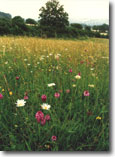We have recently rediscovered a wildflower meadow that is now under
threat by imminent change of ownership and farming methods.
In addition to it's importance as a flower meadow it provides
breeding habitat for a wide variety of wildlife that includes
endangered species.
The meadow covers eighteen acres representing the last refuge on Kingsmoor
still preserved by traditional farming methods.
Historically, the Tythe Map of 1840 mentions it as "the medow".
The 76 year old owner is retiring from farming and needs to sell.
He has been approached already by neighbouring farmers, more modern and intensive,
who want to buy and expand into this land.
Ted appreciates the wildlife importance and has never used chemicals
or artificial fertilisers as modern methods would require.
He mows the meadow late and only once a year. This is the traditional method,
which retains a flower rich grassland and
allows time for the open ground nesting wildlife to reproduce, explaining the presence of
skylarks and brown hares. Butterflies thrive in this increasingly rare chemical free land,
and herons fish in the
watercourses, badgers, foxes, and songbirds occupy the hedges that may soon be "grubbed
out". Hawks and owls roost in the trees as do visiting redwing and fieldfare, roe deer shelter
here when traversing between the small hills nearby to the north and south of this varied and
isolated cover. Snipe have also been noticed.
Ted could have put this land up for auction in the Spring, but is willing to
negotiate with a group of local
people for an option to purchase in an attempt to save the meadow. This option will
end on 1st September 1998, when he would have to arrange to sell on
the open market if we fail to
raise the nearly £3,000 per acre required to purchase.
To raise the funds and buy the meadow as a charity would be of great benefit to all,
guarenteeing the conservation of the ecologially important site and avoiding the
farming industry being given a bad name for its destruction. Only 2% of similar sites
that existed 40 years ago remain, causing severe threat to remaining wildlife.
The local Somerset Wildlife Trust
(SWT) surveyed the site and feel that with continued care will be maintainable at
"county wildlife site" status. The SWT director, Roger Martin, intends to be patron
of the new charity, Skylark Meadow Trust, being formed to raise funds.
SWT are willing to continue to advise the local team of
volunteers in management and additional habitat creation on this significantly
sized flower meadow if
we are successful in protecting it as a nature reserve.
It is a potential amenity that could be enjoyed by all without disturbance to the wildlife,
since viewing could be restricted during critical seasons to a newly reopened footpath
that runs just inside the south hedges.
The habitat is suitable to provide for otters along the flowing north rhine that
joins the Kings Sedgemoor river nearby to the West. The village school is in walking distance,
and the headmaster has visited the site. He feels it has great educational value and is keen to see
it preserved as a resource.
This meadowland is truly unique representing an "island of life" surviving among a
Somerset landscape that is rapidly loosing its hedges, being removed to enable larger scale
more profitable fertilizer-based farming,
which largely excludes wildlife and sadly is threating to absorb this important refuge.
A few Conservation links:
More information soon.
Mail to request addresses and telephone numbers now for
further information and for sending pledges, donations, or letters of support.
Update: Our appeal was succesful and in 1999 the meadow became a
Nature Reserve
protected by the
Plantlife
charity.
A link for providing the clouds:
strumpet of The Park Webring.
Another local(ish) rural charity: village shop
A different kind of meadow
and thoughts on ecology
Skylark page last updated 3 January 2001 - mjs

